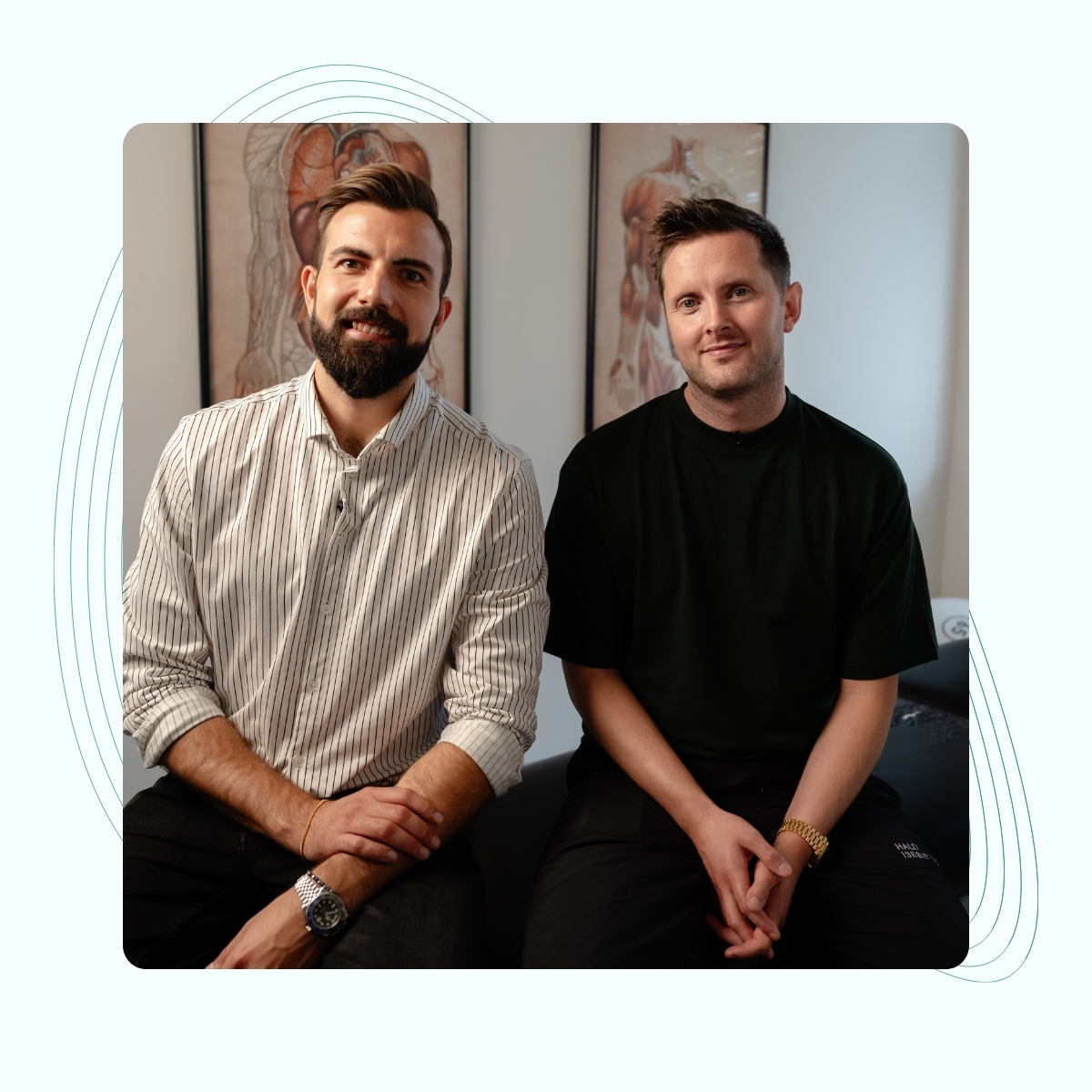We treat
Back pain
Learn more about back pain
Back pain
Most people will suffer from back pain at some point in their lives. On an annual basis, some of the population is affected by lower back pain, general back pain or sciatica. Back pain is today one of the more common causes for early retirement for people under 45.
Jump to section [Vis]
Lower back pain
Most forms of back pain affect the lower back. The lower back is where the body’s weight and center of gravity rest. This means that there are large forces that affect the lower back. The lower back, pelvis and hip are a unit, which means that lack of mobility in the hip and / or pelvis will cause the lower back to have to deal with greater strain.
The most common forms of low back pain are sciatica, herniated disc and lumbago.
Back pain between the shoulder blades
The second most common area of the back that bothers people is back pain between the shoulder blades. This area has a great deal of variation in the causes behind the pain. Sedentary work can cause a lot of strain in the form of poor posture, influences from the stomach, liver and intestinal system can also affect the area, and facet joint syndrome is a common cause.

Back pain in the middle of the back
Pain in the middle of the back often also occurs due to poor posture and sedentary work. The middle of the back is a junction where powerful postural muscles attach, namely the diaphragm and the hip flexor (iliopsoas).
When the body develops a forward-sloping posture during prolonged sedentary work, the diaphragm, together with the hip flexors, will try to straighten the body by tightening.
Other causes such as stress, scar tissue after surgery, or lower abdominal pain can affect the mid-back.
Symptoms of back pain
- Back pain, backache, locking of the back
- Fatigue and heaviness in the back
- Stiffness in the back
- Radiation to the buttocks and/or legs
This video shows 3 mobilising exercises that can help relieve pain from a locked back
Different types of back pain
There are a wide variety of types of back pain. Below are the most common.
Pain from the pelvic joints (SI joints)
The pelvic joints are formed by the pelvic bone and the sacrum. They are held together by strong ligaments on the front and back of the joint. Their function is to absorb the shock that comes from the ground, while also redistributing the load to the spine. Problems with the SI joints can result in excessive strain on the knees, back and neck.
Symptoms from the pelvic joints can include pain behind the “dimples”, pain across the lower back, severe difficulty walking after harder physical work and radiating to the buttocks and groin.
Causes of pelvic joint pain we experience can be other back pain, hip pain, knee pain, ankle and groin pain, pelvic organ dysfunction, arthritis, etc.
Sciatica (radiating pain from the back)
Sciatica is not an actual disease, but a general term for pain that radiates from the back down the leg. When it comes to actual sciatica pain, the sciatic nerve itself is affected in one or more places on its way from the lower vertebrae and sacrum to the buttocks, hamstrings and lower legs. Symptoms of sciatic nerve compression will be experienced as radiating pain – either throughout the entire leg down to the toes – or simply as pain in the buttocks and/or hamstrings. Sciatica can also be experienced as sensory disturbance (reduced sensation) in an area or on the entire back of the leg.

The body as a whole
Osteopaths look at the body holistically and examine all the different systems; joints, muscles, nervous system, organ system, blood system, lymphatic system and the cranial system.
The fact that these systems work together is crucial for healing the pain in the back (back pain). Good function of the organ system is essential for the body to be able to remedy, for example, problems in the lower back. The cranial system regulates the autonomic nervous system, which among other things controls the organ, nervous, lymphatic and blood systems.
The nervous system also controls the regulation of hormones to the organs as well as the control of blood and lymph circulation in the damaged area, so that the damaged tissue is supplied with oxygen and nutrients.
Disc herniation and disc protrusion
A herniated disc occurs when a disc of cartilage (disc) between two vertebrae ruptures, causing the soft nucleus (nucleus) to push out and press on a spinal nerve or sometimes the spinal cord itself. Symptoms of a herniated disc or herniated disc may include radiating pain in the legs, calves and feet – pain that is often worsened by coughing – numbness in the leg and/or decreased strength in the leg.
Weight-bearing activities will often affect disc herniation and disc protrusion, as shock and gravity compress the disc.
Facet syndrome – facet joint syndrome
Facet syndrome or facet joint syndrome covers several problems in the facet joints found between the vertebrae. Symptoms of facet syndrome are tightness or locking in the spine (neck and thoracic spine), pain and tension between the shoulder blades and sharp jabs in the back. This type of back injury can come on gradually, but can also come on acutely after physical work.
Causes of facet syndrome can be dysfunctions in organs secondary to lack of mobility elsewhere in the body, stress, one-sided and sedentary work, etc.

Lumbago (pain in the lower back)
Like facet syndrome, lumbago is a syndrome that covers several problems in the lower back.
Symptoms of lumbago can include sharp pain in the lower back when running, fatigue and heaviness in the lower back after physical work, radiating to the buttocks and severe stiffness in the lower back – especially in the morning.
Causes of lumbago pain can be other back pain, hip pain, knee pain, ankle and foot pain, dysfunction in pelvic organs, secondary to lack of mobility elsewhere in the body, etc.
Other symptoms of back pain
Back pain, backache, myosis, scoliosis (curved back), locking in the back.
Back pain and cancer
Symptoms of cancer can include significant weight loss associated with back pain, persistent and worsening sciatica pain, back pain at night, pain that does not subside with changes in position or activity, symptoms in both legs. These symptoms should be taken seriously and you should seek medical attention.
Medication for back pain
As far as possible, medication should be avoided for back pain if the cause has not been determined. Various types of inflammation such as arthritis in the back often benefit from NSAID preparations such as ibuprofen or ipren. Ordinary paracetamol should be used for pure pain in, for example, lumbago, sciatica, herniated discs, etc.
When should I see a doctor for back pain?
Symptoms such as numbness down the leg, severe weakness in the leg, lack of control over bowel and bladder control, falls due to lack of strength in the leg, or persistent pain in the back and legs are indications that something structurally may be damaged or wrong in the back.

Back pain and lower back problems can originate from elsewhere in the body
For example, kidney problems can cause increased tension and irritation in the nearby quadratus lumborum muscle, which can cause back pain. Problems in the cranial system and neck pain can reduce kidney function through our largest cranial nerve. Kidney problems will increase irritation of the back through the autonomic nervous system between the thoracic spine and the lumbar spine, which will reduce blood circulation in the area – especially if the problem persists for a long time.
The body can heal itself and back pain
Under the right conditions, the body can heal itself. If all systems work together and separately, excessive mechanical stress on the back, inadequate transport of oxygen and nutrients to and from the area and insufficient nerve supply can be avoided. This way, the body will have optimal conditions for healing. Osteopathy stimulates, regulates and restores all of these systems.
Back pain often requires physiotherapy rehabilitation (a physiotherapist specializing in back pain) to strengthen and stabilize muscles and connective tissue.
Back pain at different times of the day
Certain types of back pain occur at certain times of the day and/or with certain activities. Here you can get an overview of which factors affect your back.
Back pain in the morning
Back pain in the morning that gets better during the day is always due to the circulation, i.e. the venous system. Because the circulation is inactive at night (the respiratory pump and the venous pump), the blood has the opportunity to stagnate or accumulate in the lower pelvis and cause back pain.
Back pain at night
Back pain at night can, in the same way as back pain in the morning, be caused by circulation. Back pain at night can also be caused by inflammation or irritation in the back. Fractures in the back, such as osteoporosis (bone fragility), or collapse in the back can cause pain at night.
Back pain in certain positions
This type of back pain is caused by the capsule or ligaments in the back that do not like to be stretched. Facet joint syndrome or misalignment of one or more vertebrae is the typical cause.
Back pain increases during the day and with strain
Back pain that increases during the day and/or with strain can often be caused by problems in the spine such as herniated discs, herniated discs, spinal stenosis, spondylolisthesis or similar problems.

Causes of back pain
There can be many different causes of pain and soreness in the back. Aarhus Osteopathy examines and considers the body and back as a whole, i.e. we find the right cause(s) of back pain. This pain can be caused by problems and dysfunctions in many places in the body. The causes below are just the most frequent.
Neck and back pain
Problems in the neck can directly and indirectly cause problems in the back and lower back. From the brain and neck, the spinal cord runs along with the dura mater. This membrane is related to all areas of the spine itself and all nerves that come out of the spinal cord.
Concussion and back pain
Head injuries and blows can and will affect the hormonal and nervous systems in the body. This often has a negative impact on circulation, which can lead to heaviness and fatigue in the back.
Sedentary work and back pain
Sedentary work negatively affects the circulation and the body’s connective tissue. The venous system stagnates and accumulates around the body, especially in the back. Over time, tightness in the body’s connective tissue will lead to poor posture.
Organ system and back pain
The organ system can in many cases cause referred pain to the back. For example, if the liver is not healthy due to a poor lifestyle, the liver will send pain signals to the back.
Scar tissue in the body and back pain
Scar tissue is one of the biggest traumas the body can be exposed to. Scar tissue causes the body’s connective tissue to become tighter, which always causes the body to compensate.
Pelvic and back pain
The pelvis forms a unit with the lower back, which means that if the pelvis does not move optimally, the back must move correspondingly more.
Hip and back pain
In the same way as the pelvis, the hip also forms a unit with the pelvis and the back.
Knee/foot and back pain
Problems here will cause increased strain throughout the body, including the lower back. Running and walking can therefore cause back problems.
Osteoporosis and back pain
Collapse of the spine is also one of the causes of back pain.

Osteopathic approach to back and lower back pain
- To find and optimize the areas the back needs to compensate for, so that the back pain/irritation can heal.
- To optimize blood circulation in the area. Treatment of the heart, lungs, chest, respiratory muscles, liver, intestines and left kidney is important.
- To ensure optimal function and mobility around the lower thoracic vertebra and upper lumbar vertebra, as this area is crucial for blood flow.
- To optimize the function and mobility of the lumbar vertebra itself corresponding to the pain in the back.
- To optimize the immune system, diet and lifestyle, and to treat the adrenal glands.
Good advice for back pain
There are many factors that affect whether pain-causing structures in the back can heal. Below is good advice for back pain as well as good advice that can be used preventively with back pain.
- If you have a sedentary job, it is extra important to work on the flexibility of your body (chest, lower back and pelvis) and to get your heart working at least once a day for about 30 minutes.
- Prioritize your sleep (very individual but generally around 7-9 hours) – important structures in the back are strengthened and nourished at night when you lie down.
- Reduce stress, busyness and mental strain in everyday life – these factors reduce the function of your systems (organ system, blood system, nervous system, etc.), which has a negative impact on back pain.
- Think about what you eat – foods that give you bloating and stomach cramps negatively affect back pain.

Ischiogluteal bursitis
Between the ischium, the gluteus maximus muscle and the hamstrings there is a sac of mucus that helps to reduce friction. The sac can become irritated and inflammation can occur.
Causes of ischiogluteal bursitis
The most common cause is sitting for a long time, for example when cycling with a hard saddle, or a hard office chair.
Symptoms of ischiogluteal bursitis
The symptoms are pain around the ischial tuberosity when sitting. The pain disappears as soon as you stand up again.
Treatment of ischiogluteal bursitis
The treatment primarily consists of relieving the pressure from the hard surfaces that may have provoked the irritation.
Stability training for back pain
Stability training of the back and pelvis as well as core training have a good effect on back pain. This type of training activates the small muscles of the back that hold the joints in place. Core training also holds the intestines and pelvic organs in place and promotes the blood system in and around the organs.

Often related injuries
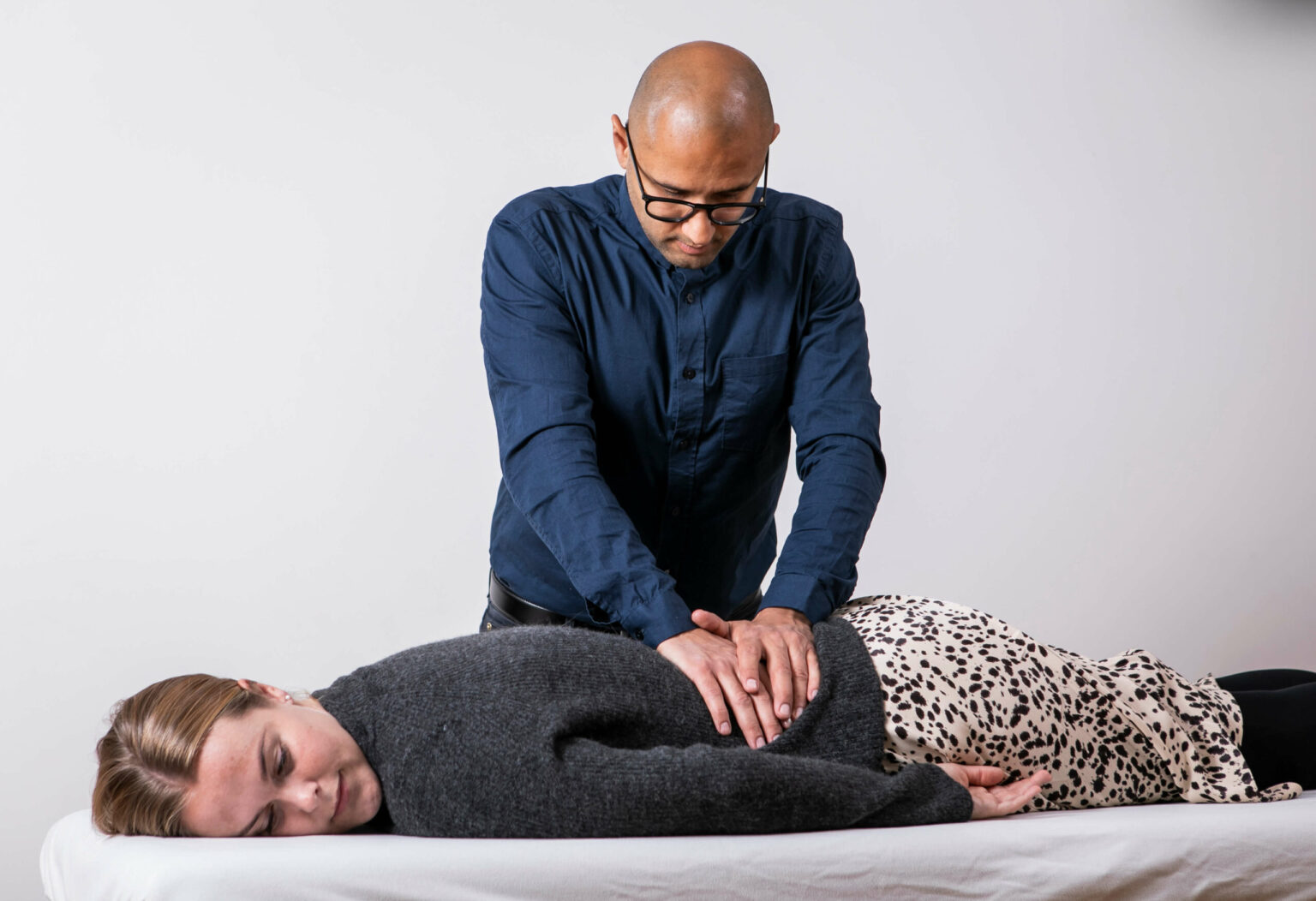
Spinal stenosis
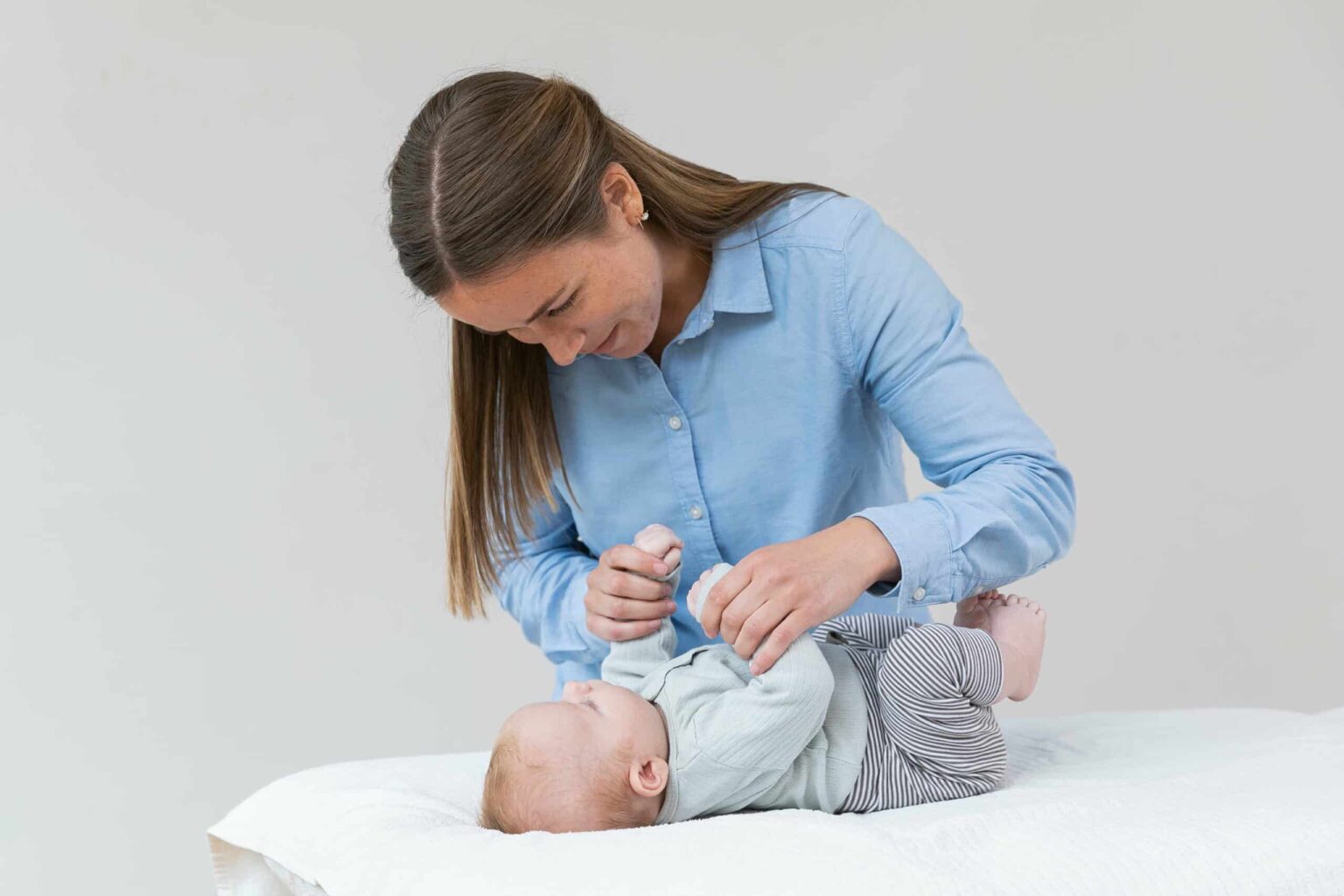
Hypermobility in babies and children
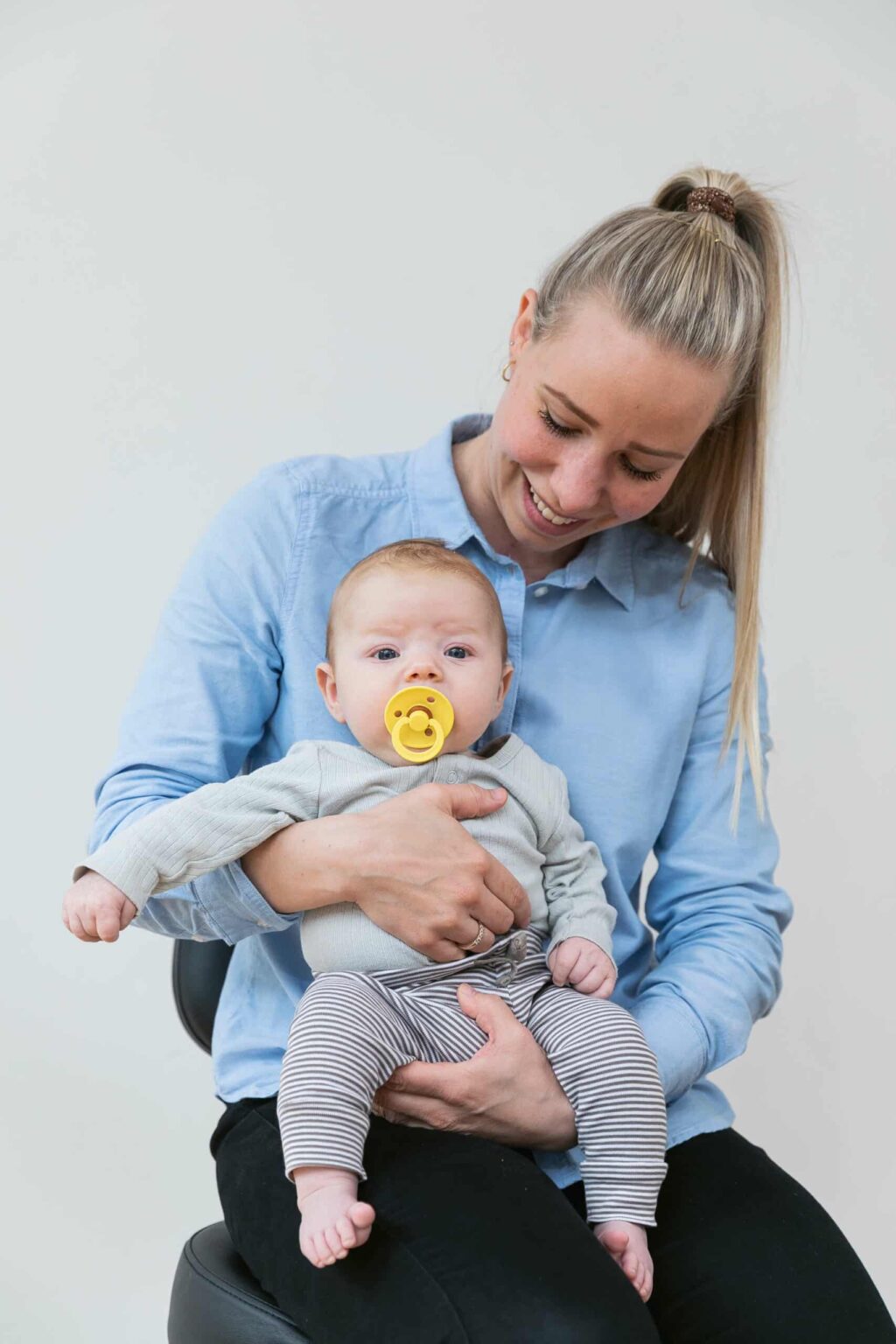
Muscle tension or imbalances in babies and children
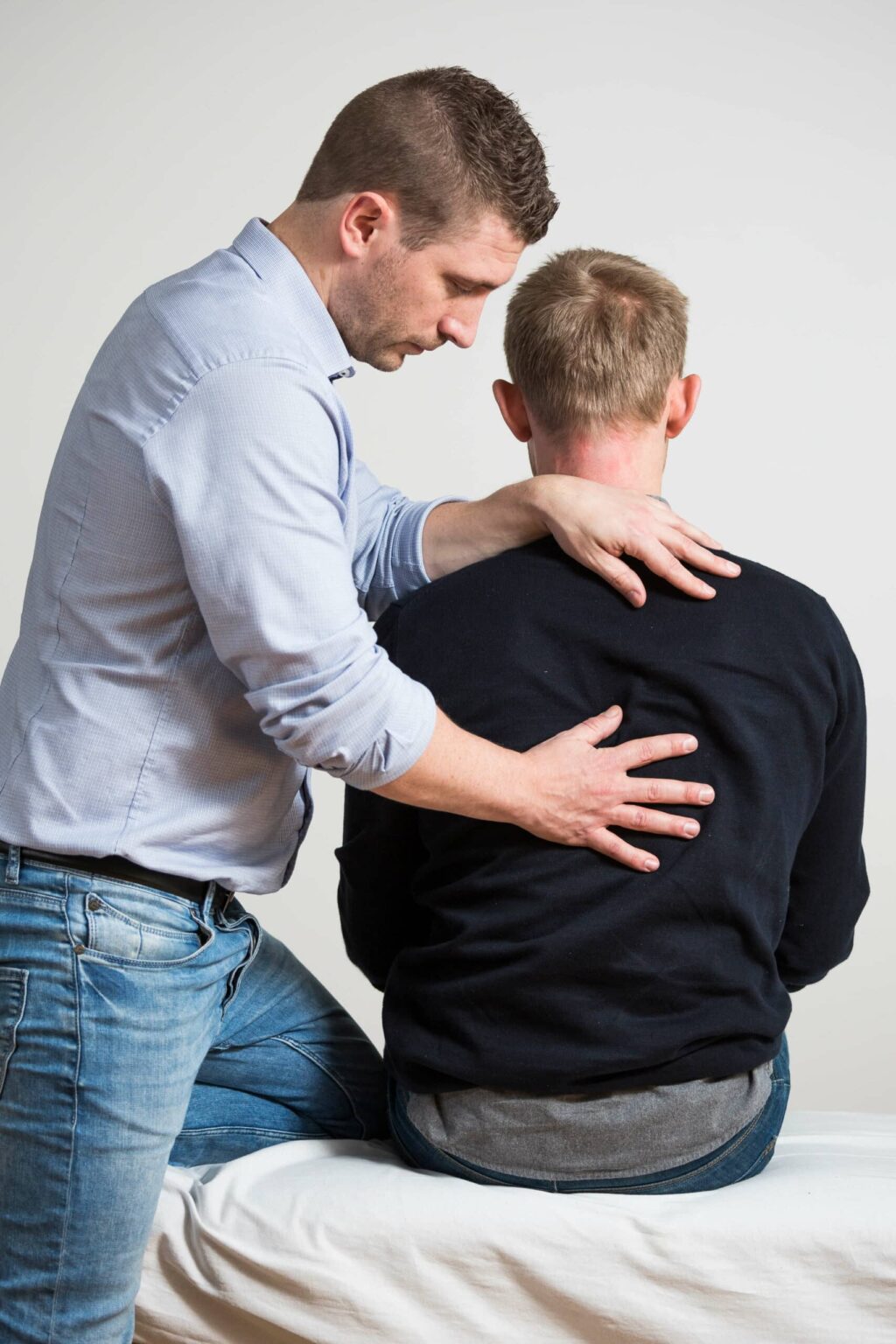
Modic Changes
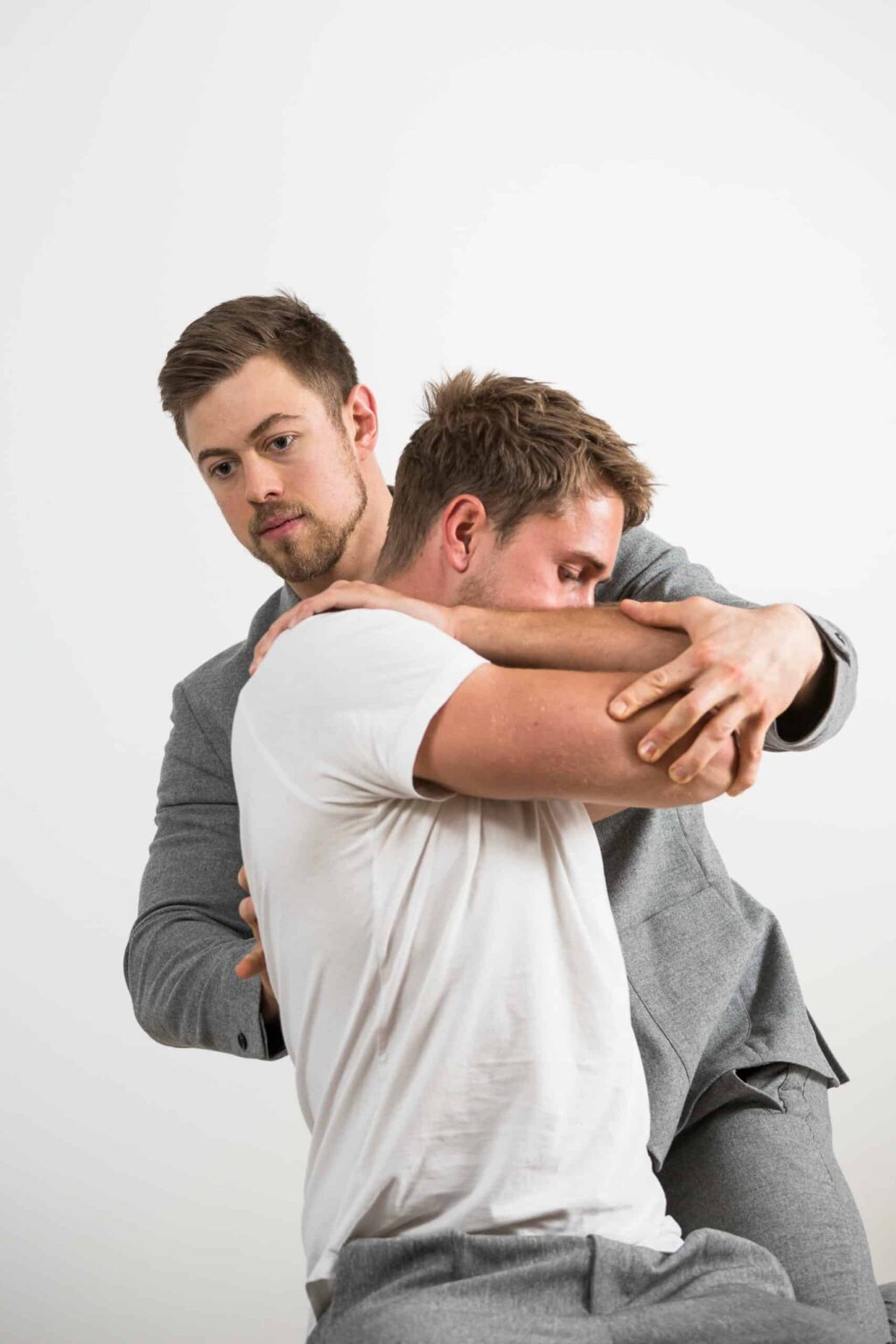
Disc herniation
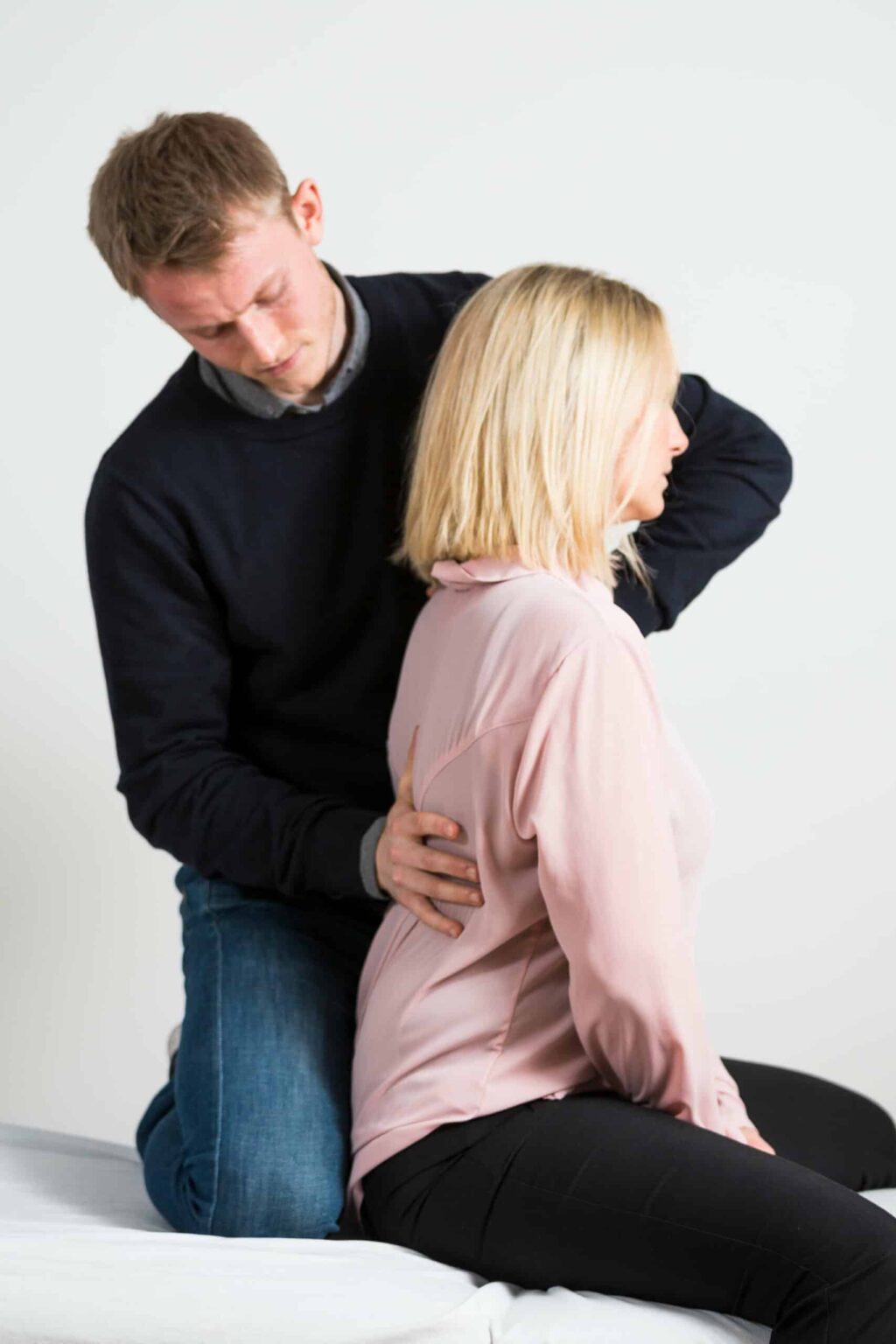
Spinal arthritis
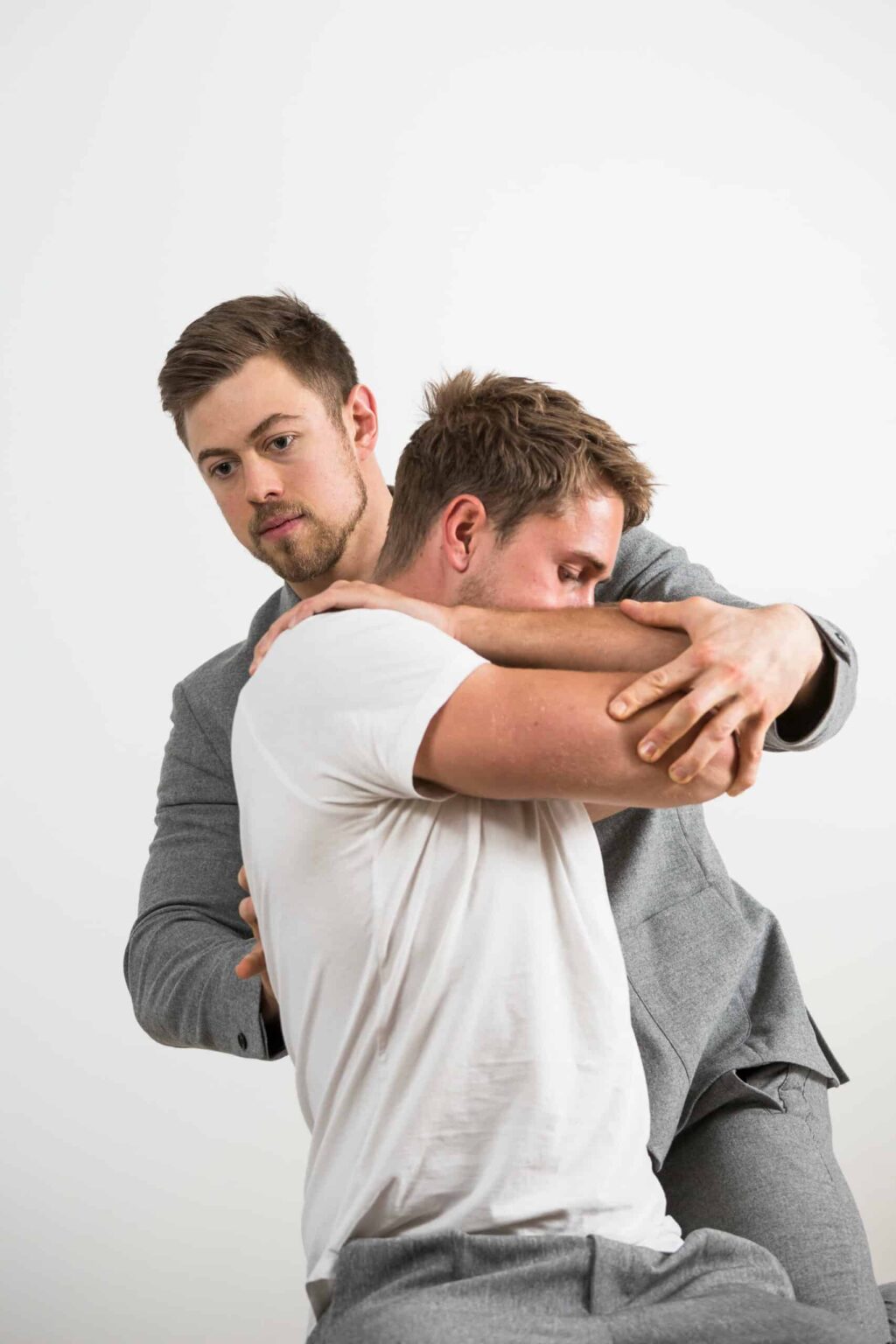
Winged scapula

